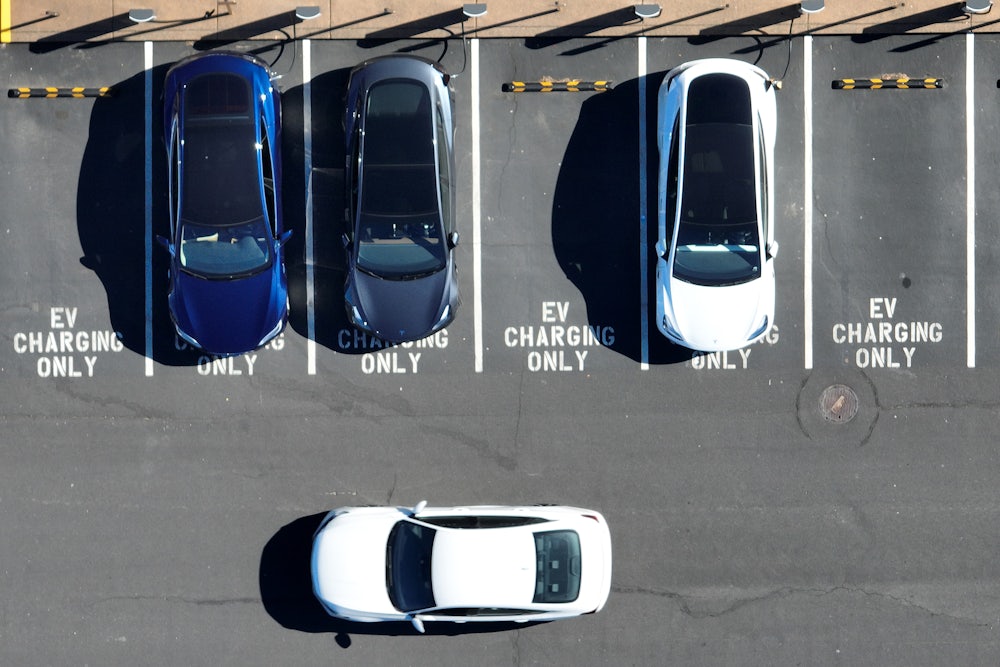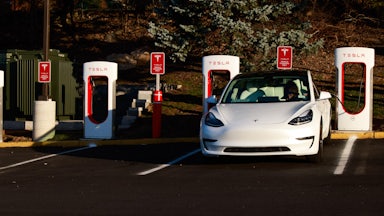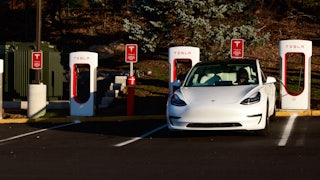Twelve years ago, Nissan took a swipe at carmakers’ longtime ally, the fossil fuel industry, with its “Gas Powered Everything” campaign. Multiple ads for the company’s Leaf model, its first electric car, featured people going about their daily lives—but with combustion motors attached to everything from alarm clocks to hair dryers, all of them spewing exhaust.
“What if everything ran on gas?” a disembodied voice asks in one ad. The camera pans to a man quietly unplugging a Nissan Leaf. “Then again, what if everything didn’t?” the voiceover says.
A new spot from ExxonMobil, released July 10, takes the same concept and reverses it, painting electrification as an onerous tethering to the grid. People wake up, have meetings, go for runs, even go on dates wrapped in miles of cords and looking absolutely miserable under the weight of it all. The solution appears on screen as the central character steps into a gas-powered car. “Disconnecting: Feels a lot like breaking free,” a caption reads.
This ad may seem innocuous, but it looks like the first big public rift between two industries that have spent a century working side by side. Automakers and oil companies first joined up to bust unions in the early 1900s, then to push infrastructure and culture toward car dependency in the 1950s and, in the 1980s and ’90s, to block climate policy. The big American car companies have historically belonged to all the same climate-denying coalitions as the U.S. oil majors, including the Global Climate Coalition, the cross-industry group largely responsible for killing a crucial international climate treaty back in the late 1990s. For decades, Big Auto and Big Oil were on the same page about electrification too: It was bad for business. But cars like the Leaf comprised so little of the overall market share that they posed next to zero threat to gas-powered models.
Today, that’s all changed. Electric vehicles’ share of the auto market has tripled in three years, all the major automakers have multiple E.V. models, and the transition seems unstoppable. As with any big breakup, things are getting complicated and messy. And, if the Exxon ad is any indication, the first public stage of this titanic fight seems set to play out in advertising.
The fossil fuel industry has historically had four key drivers of revenue: transportation, petrochemicals, residential energy use, and industrial energy use. In the United States, 67 percent of petroleum produced goes toward transportation; the next biggest slice of the pie is industrial, at 26.9 percent.
The fossil fuel industry has been preparing for electrification to eat into its slice of profits from cars for a while. Over the past decade, there have been clear indicators that electric vehicles were on the rise: China set a target in 2014 for 20 percent of new cars to be E.V.s by 2025 (they’ve already met it), every major automaker has released E.V. models in the U.S. and pledged to phase out gas-powered cars, and the number of available chargers worldwide has skyrocketed since 2015.
In an effort to keep profits up, the fossil fuel industry invested in other sectors like carbon capture, hydrogen, and sustainable aviation fuels, while also ramping up petrochemical production. Exxon, for example, invested heavily in petrochemicals growth in Asia and quietly became the world’s largest producer of single-use plastics. BP and the International Energy Agency predicted that as fossil fuel use in transportation fell, about half the industry’s future growth would come from petrochemicals, particularly those that feed into the production of plastic and synthetic fabrics.
The industry’s ads followed suit with this shift. Multiple ad campaigns from various fossil companies debuted over the past few years have reminded us all that almost everything we touch probably has a petroleum-related product in it. Meanwhile, oil companies’ P.R. went hard on attempting to convince the public they were part of the solution on climate change, launching a barrage of advertising on their efforts to reach “net-zero” and champion supposed clean energy solutions.
But the transition to E.V.s is happening faster than anyone expected—with no small thanks to new incentives in the Inflation Reduction Act. The global explosion of demand for single-use plastics that the fossil fuel industry was banking on, meanwhile, has not materialized. By 2020, analysts were already cautioning that the industry’s petrochemical projections were overly optimistic. Three years on, the industry has just not been able to create demand quickly enough.
In the U.S., oil companies have been hauled into court and congressional hearings, and tarred and feathered in the public square for greenwashing. The conflict in Ukraine and the global energy crisis have made profits from fossil fuels skyrocket once again; BP, Exxon, Total, and Shell have walked back a substantial number of their previous climate commitments this year. It seems that oil companies may be ready to stop pretending that they’re part of the climate solution and get back to raking in record profits. This is an industry that knows its days are numbered, and it’s going to spend the last of them making as much money from its assets as it possibly can.
Cue the dark lighting and heavy electrical cords in the Exxon ad—and the return of one of the industry’s most tried and true propaganda techniques.
Exxon’s official response to the ad is that there’s nothing to see here. In response to my questions, company spokesperson Julie L. King claimed the ad was not meant to be anti-electrification. “EVs are an important part of a lower-emission future and another great way to enjoy the open road,” she said, via email. “The ad is about disconnecting from our devices, hitting the open road and enjoying our surroundings.”
Melissa Aroncyzk, a media studies professor at Rutgers University, said the company and its agency have been smart to bake in plausible deniability to both the ad itself and their outreach to journalists. “They are trying to play on a certain ambiguity by emphasizing in the press that they’re just urging people to consider taking a drive to break free from the stress and constraints of modern life,’’ she said. “So it’s even more insidious because they are well aware of the E.V. angle but they’ve also crafted an escape hatch in case they get heat from journalists.”
Putting the ad out under the Mobil1 brand rather than ExxonMobil could be part of that strategy. Mobil1 engine oil could potentially be used in the gearbox of an E.V. as well as in gas-powered cars, making it easy for the company to claim that the campaign is vehicle-agnostic—except that the ad only shows gas-powered cars, despite multiple different versions of the ad featuring different types of drivers. And for all the gaslighting, the message seems awfully clear. In one ad, a woman watches a combustion car drive by and looks down, dejected, at a cord that looks a lot like the ones connected to E.V. chargers.
“This ad illustrates the regressive shift from excessive greenwash back to blatant climate denial,” Christine Arena, a former advertising executive, told me. In the 2010s, Arena helped the fossil fuel industry greenwash its product as a V.P. at Edelman; since then, she has been called upon to testify about oil companies’ advertising tactics in congressional hearings. “High on war profits, Exxon is done pretending to be advancing climate solutions. By celebrating oil as freedom and condemning clean energy as a kind of captivity, it demonstrates the classic propaganda tactic of warping the truth and cloaking its polluting product in a universally accepted ideal.”
Fossil fuels as the path to freedom is a trope the two industries once shared. “Back in 1920, car ads were already extolling the virtues of escape and individual pleasure,” Aronczyk said. She pointed to one particular example where the ad copy read: “No longer the blasé driver of yesterday. You are the companion of a new kind of car—answering the call of the open country—yielding to the whims of the moment—a royal vagabond traveling the road to Everywhere.”
Fossil fuel companies attacking E.V.s doesn’t mean automakers are suddenly climate heroes for simply running ads promoting their electric options, by any stretch of the imagination. According to statistics from ad data service Media Radar, auto majors are spending more than twice as much to advertise large electric trucks and SUVs as they are for smaller E.V.s. These models require larger batteries and thus more critical minerals like lithium, the mining of which takes a tremendous toll on ecosystems. Automakers want to see people replace their combustion engine vehicles with electric models, not chuck their car altogether in favor of public transit, walking, or biking, which will stop the electrification of transportation from delivering the sorts of emissions reductions the architects of the IRA are aiming for.
Still, a big, splashy anti-electrification ad campaign from ExxonMobil marks something of a turning point. These are two of America’s largest industries. They’ve worked together for about a century to hook the country on fossil fuels. They’re also two of the world’s biggest advertisers. If the industries are about to spar over the future of transportation, big ad agencies may increasingly be caught in the middle.
“Ad agencies are trying to play both sides of the climate issue, and it just doesn’t work anymore,” Duncan Meisel, executive director of Clean Creatives, said. “If automakers want to meet their goals for selling electric vehicles, they need the exact clean energy policies that the fossil fuel industry is lobbying to stop. That’s a conflict of interest, and a conflict of values. If agencies want to attract talent that is interested in being a part of the climate solution, they can’t keep working with the polluters blocking them.”
Martin Williams Advertising, the agency of record for Mobil1, did not respond to requests for comment, but creative director Matt Pruett said in a LinkedIn post that the ad was “all about technological ties that (literally) bind and how to break free.” Meanwhile, Stink Films, the creative production house hired to create the ad, sidestepped the issue: “Commercial directors are really just work for hire employed by ad agencies to produce the content that their clients have commissioned,” Mungo Maclagan, the studio’s executive producer, said.
As two of America’s largest industries speed toward very different futures, we can probably expect more of these sorts of campaigns, and the lobbying that typically accompanies them. From ad agencies to law firms, production houses to P.R. flacks, industry enablers may have to choose sides for the first time in history.
“These intermediaries have agency,” Aronczyk said. “They can say ‘no’ to a compromising client, and they would do so if they felt their reputation was at stake.”










